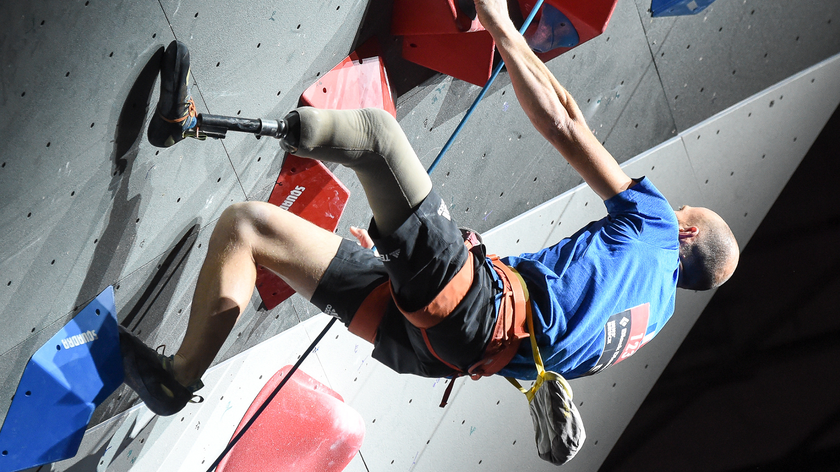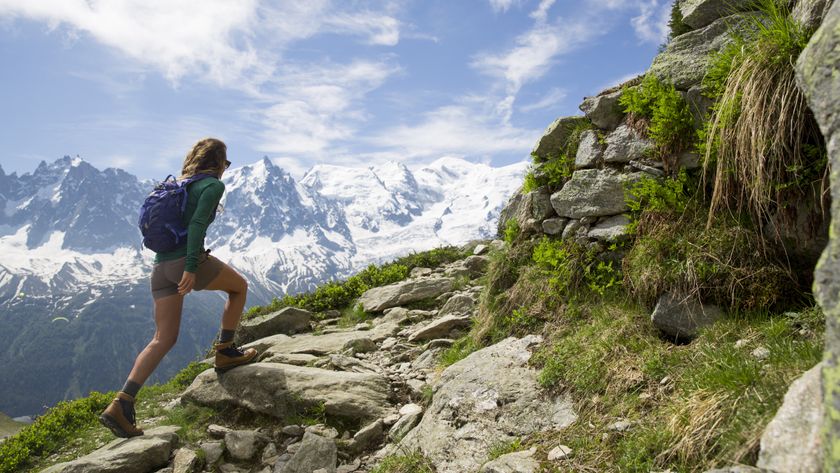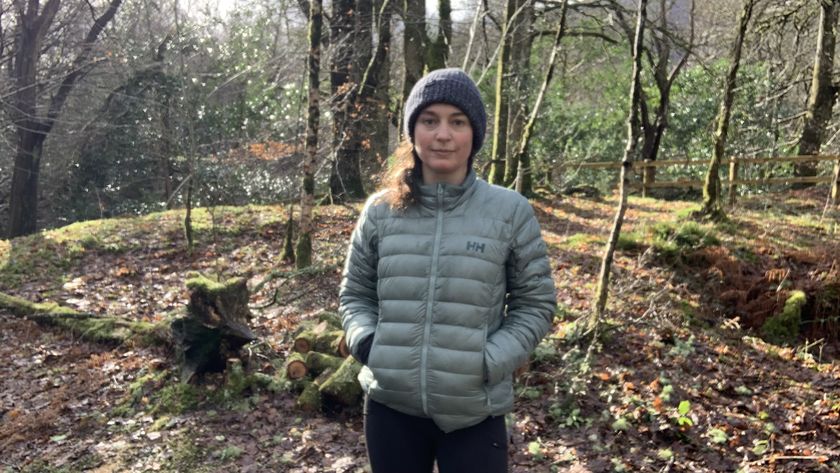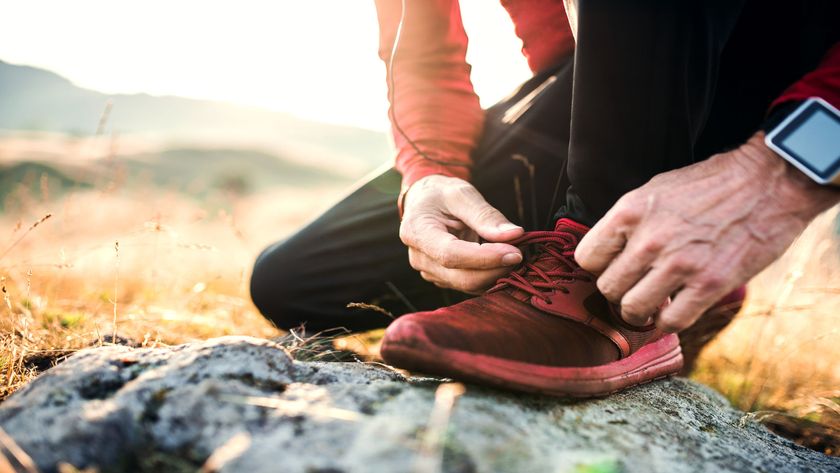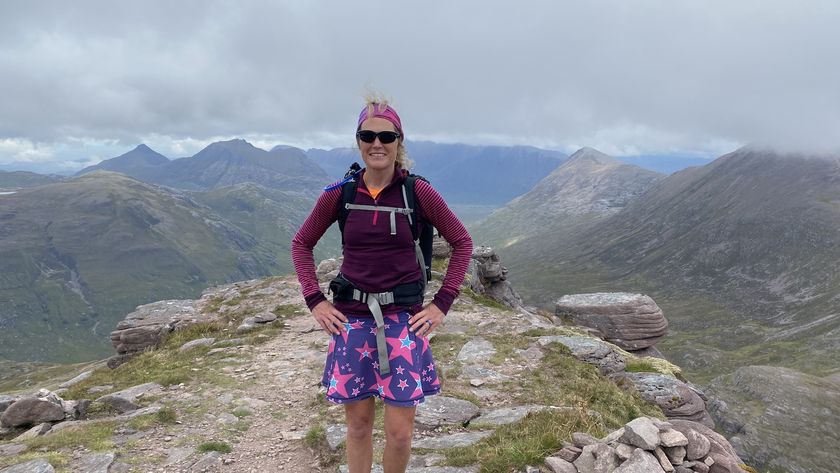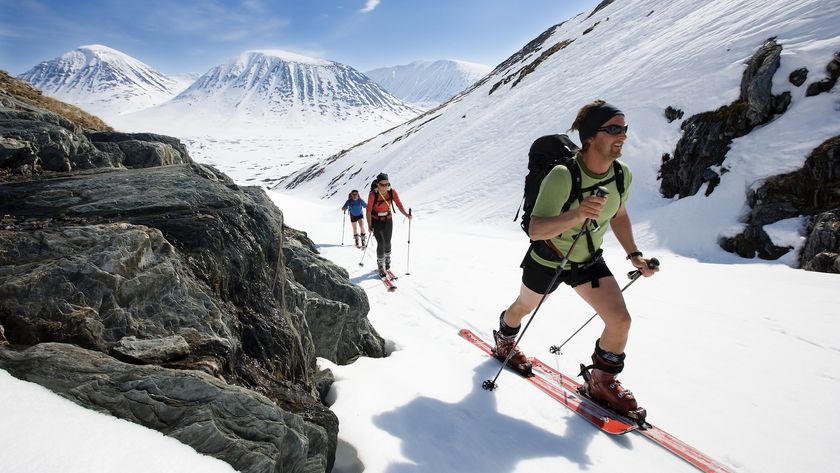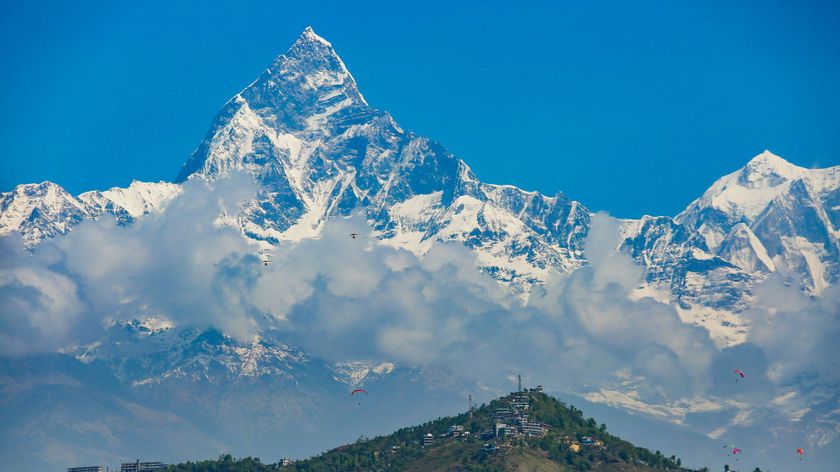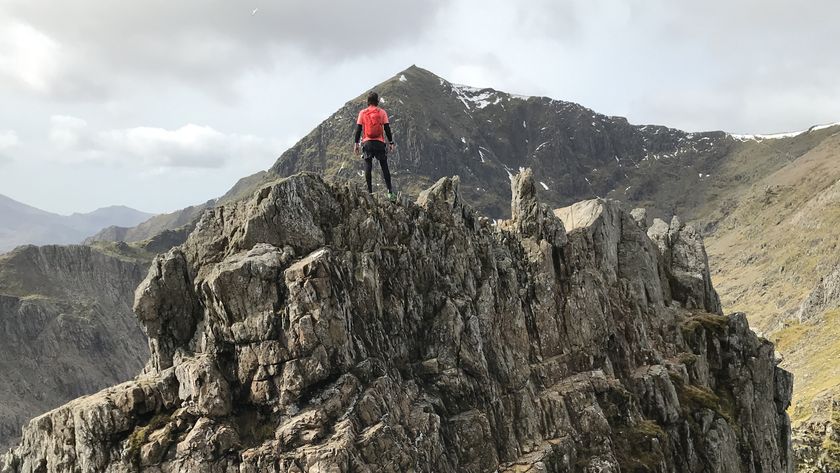I'm an avid runner: here’s how I update my trail running kit for winter
A guide to what you should be wearing for winter runs on local trails, in the hills and in the mountains
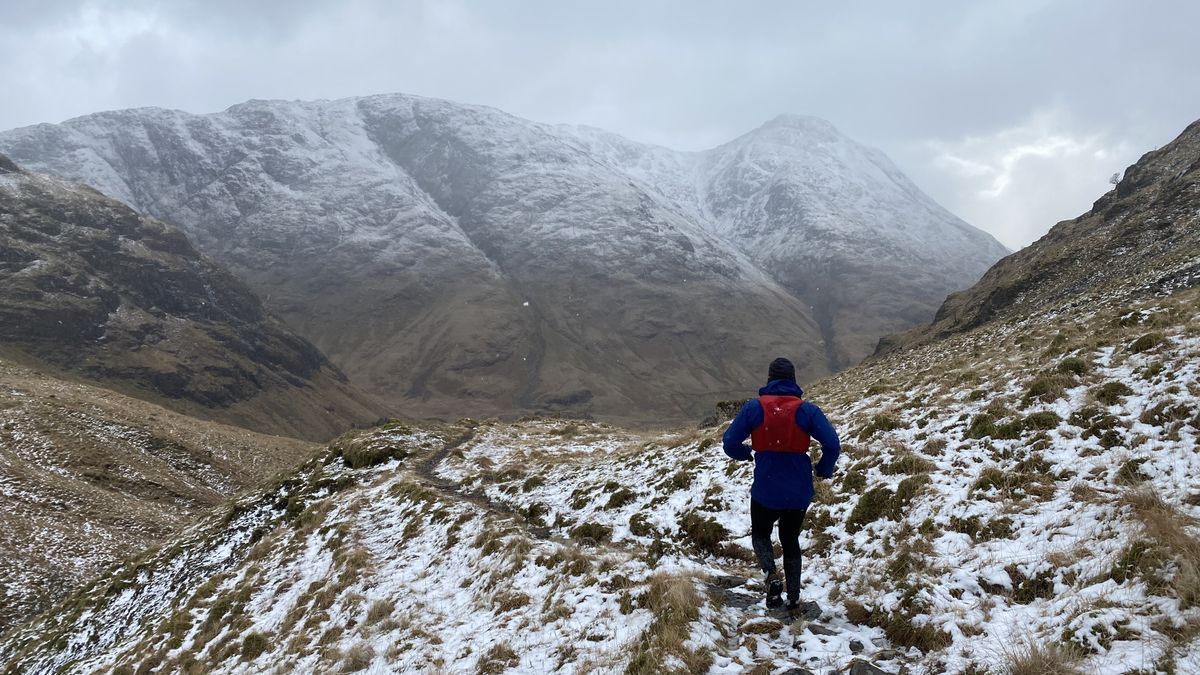
There are more hurdles to overcome where winter trail running is concerned. Shorter daylight hours, less appealing weather and freezing temperatures all conspire to test the motivation of even ardent runners and, for the more extreme runs, you’ll need extra kit in the colder months.
However, shift your mindset and winter becomes the most rewarding time. Battling inclement weather and coming out the other end smiling provides a real buzz. There’s the novelty of headlamp-lit, after dark adventures, or the beauty of a sunrise or sunset session. Heading out into snow-dusted hills and mountain valleys is epic; coping with the conditions adds a sense of self-reliance, resilience and confidence.
So, don’t be put off by the cold and the dark. Get your gear sorted and embrace it. Read on to find out how.
How I update my trail running kit for winter
The term trail running covers a broad spectrum of potential adventures, from a quick 5k in the local woods to epic, ultra-distance journeys in the hills and mountains. For the purposes of this feature, I’ll go into what I’d wear for shorter casual runs and what I’d wear and take for the bigger adventures.
Grippy and protective trail running shoes: Aggressive lugs and protection are important in winter
Socks: For me, the same moisture wicking socks will do for winter as in summer
Thermal leggings or shorts: More mountainous runs demand thermal leggings as opposed to shorts
Advnture Newsletter
All the latest inspiration, tips and guides to help you plan your next Advnture!
Base layer: Try long sleeves for colder weather, while hybrid Merino tops are a good choice
Lightweight jacket: A lightweight running jacket is essential for more adventurous runs
Hydration pack: For carrying water, fuel and emergency items on longer runs
Headlamp: I extend my potential running window by wearing a headlamp
Emergency items: A packable down jacket, first aid kit, emergency blanket and tracking device are all ideal for longer runs
Running poles: Lightweight running poles take some of the strain and aid stability
Grippy and protective trail running shoes:
- Aggressive, grippy lugs are needed for winter's soft terrain
- For longer mountain runs, protection and comfort are important
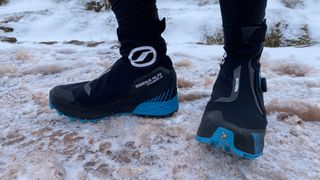
Winter is generally wetter and the fewer hours of sunshine mean that all that water has a harder time evaporating than in the warmer months. This leads to saturated ground, muddy trails and boggy hill and mountain terrain. Without the right traction, one can end up a bit like Bambi on ice. So, when the colder months come around, my summer trail shoes go into hibernation, replaced by winter trail running shoes with more aggressive lugs for grip on sloshier ground.
My chosen pair for local runs on my woodland trails is the inov-8 X-Talon, a similar model to the Mudtalon reviewed by our very own Pat Kinsella. The toothy outsole is perfect on soft, slippery ground. For longer hill runs, I’ve always been a fan of the Salomon Speedcross series, which deliver comfort and protection and perform very well in the high places.
The nuclear option for skyrunning above the snowline is something like Scarpa’s Ribelle Run Kalibra G or La Sportiva’s Cyklon Cross GTX, which feature integrated gaiters, very high levels of protection and water-resistant qualities, while still being breathable. However, these kinds of shoes are heavier and certainly overkill for most runs.
Moisture wicking socks
- I wear quality, moisture wicking socks throughout the year
- Some people prefer waterproof socks for winter
Personally, I don’t change my running socks for winter runs, opting to stick with the same Merino mix pairs I wear for summer runs. Some prefer waterproof socks for the colder months but these tend to be less breathable, so you can end up with sweaty feet. Of course, if I’m heading out for an epic adventure run or a long race, I want to keep my feet as dry as possible. One option is a foot cream such as Trench, which many ultra runners and long-distance hikers swear by for preventing blisters.
Thermal leggings or shorts
- I find that shorts are fine for my everyday runs
- Thermal leggings are ideal for cold, mountain runs
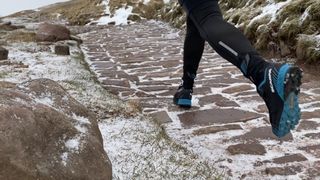
Depending on the type of run, I’ll opt for either thermal leggings or shorts for my winter runs. Shorts tend to suffice for standard training runs and, if it’s a bit nippy, there’s the option of twin-layer shorts for added warmth. These also have the advantage of a next-to-skin sweat wicking layer and reduced chafing.
Thermal leggings are my choice for runs in the hills and mountains, providing a lightweight shield against windchill and wicking moisture away from my legs. They also double up as a base layer option for winter walks and the like, so I get plenty of use from them.
Base layer
- A moisture wicking, long sleeved base layer is best for keeping you warm
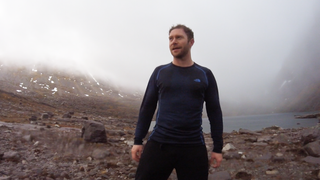
For my everyday winter runs, I bound about in the same polyester tees as in summer – the Ronhill Golden Hour Tech Tee is my fave. However, I don’t tend to suffer much from the cold and many people may prefer the additional warmth of long sleeves. When it comes to the more adventurous outings in the mountains or longer distances, I swap in a long-sleeved base layer.
When it comes to materials, many swear by Merino wool, as it’s moisture wicking, odor-repellent, insulating and breathable. But in my view a blend of Merino and synthetics is better, especially when it comes to providing the stretch needed for unencumbered movement and for durability.
Lightweight running jacket
- I tend not to wear a jacket for everyday runs
- I do wear one during adventurous mountain runs for safety, warmth and comfort
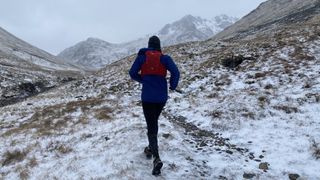
I see people running in all sorts of outer layers in winter – a classic cotton and polyester hoodie is the worst offender. Cotton absorbs and retains water, adding weight and making for an uncomfortable, stuffy run. For a running jacket, I want something that’s lightweight, packable and breathable, while still offering protection against wind and rain. A dedicated running jacket is preferable to a standard waterproof jacket, as it will be tailored more towards breathability – an essential quality for dynamic pursuits.
Admittedly, I run hot, so for shorter training runs at ground level, I never wear a running jacket, even when the temperatures are hovering around the freezing level. The start of such a run can be a little nippy but, once I get going, I’m soon producing enough heat that I don’t feel the cold and I’d find wearing a jacket a little bit stuffy. However, I’m aware that everyone has different levels of tolerance for the cold – it’s a personal thing.
However, for the more adventurous hill or mountain runs in my life, a running jacket is an absolute essential for both safety and comfort. They tend to be highly packable and weigh very little, so they take up very little room in a hydration pack. I usually start my run without but, once I hit the high ridges and windchill rears its head, these lightweight outers are an absolute must.
Gloves and hats
- I tend not to wear gloves until it gets really cold
- People who suffer with Raynaud's Syndrome should cover exposed skin
- For mountain runs, I pack gloves and a hat

Many people choose to head out wearing running gloves and hats once temperatures drop to the levels where our breath mists before our eyes. However, I find that they’re a bit too much on shorter runs, even when its freezing. In my opinion, a temporary discomfort at the start of a run is better than feeling clammy and having to carry them later on. As mentioned, I run hot, so many people would choose to wear thin liner gloves and a beanie on cold weather runs. This is especially true of those who suffer from Raynaud’s Syndrome – if this is you, don’t allow bare skin to be exposed to the cold air or wind.
As with running jackets, I’ll start to think about gloves and hats once things turn more mountainous and I’d typically start with them in my pack and only deploy them if necessary. Dedicated running gloves are preferable to hiking gloves – they often feature reflective detailing and are touchscreen compatible. I like to take photos and videos while I'm out, so touchscreen compatibility is important too.
Hydration pack
- A hydration pack provides storage for all the winter essentials
- Larger capacities are needed for mountain marathons and the like
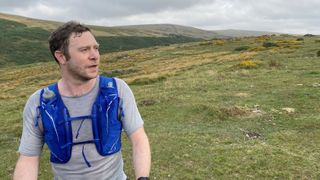
There comes a point, either in terms of distance or the manner of the planned route, where a hydration pack (also called a hydration vest) is needed. For standard winter training runs that’ll take less than a couple of hours, I don’t feel the need to carry a pack. However, for longer, more adventurous hill runs, these lightweight storage vests provide the capacity I need for soft flasks, energy gels, other snacks, a small first aid kit, a jacket or two, hats, gloves and a phone, while they also tend to feature running pole attachments too.
I find that I don’t need tonnes of storage for most winter hill runs. I can squeeze most of the above, including an emergency down jacket, into my 6-liter Osprey Duro. More kit, and therefore more capacity, is necessary once you start eyeing up events like mountain marathons or long skyrunning challenges.
Headlamp
- A headlamp extends your potential running hours during winter
- A runners' headlamp should be lightweight and not bounce when you're running
- If you run on roads, get a lamp with a red backlight

One of the main barriers to getting out in winter is the shorter daylight hours. I often find that fitting in a quick blast on the local trails under the light of the sun can feel impossible with work, social and family commitments all jostling for space. I’m not much of a morning person, but even those committed early birds who manage to get out the door before their children stir or work beckons are faced with darkness in mid-winter.
A headlamp is the answer, opening up the pre-dawn and the long winter nights for running adventures once more. It’s also an essential safety net on adventurous mountain runs, where the consequences of getting caught out in the dark could be serious – I always take two. Dedicated running headlamps are typically lighter than standard hikers’ headlamps (though many work well for both) and are designed to remain stable while you bound along the trails. If I’m running on the road at all, I take a lamp with a rear red light so that cars can see me from behind.
Emergency items
- A customized first aid kit with spare laces is a good idea
- Additional insulation in case of injury is essential
- Take a packable puffer and an emergency blanket
- It's worth allowing loved ones to track you, especially if you're running alone

If I’m taking a hydration pack, it’s probably because I’m headed somewhere remote and potentially mountainous on my running adventure. At this point, certain emergency items are worth bringing along – just in case. I always take spare laces along in a small first aid kit so that a snapped lace doesn't become an issue. I also remove anything unnecessary from the first aid kit – every gram counts and the odds of needing burn cream on a snowy run are pretty slim.
The main danger in winter, particularly in remote mountain areas, is getting an injury and becoming incapacitated. Movement equals warmth and, as you’ll probably know, as soon as you stop moving in the mountains, you’ll get cold very quickly indeed. If you’ve been working up a sweat before your injury, you’ll cool down especially quickly and be at risk of hypothermia. So, I always carry a packable down jacket and sometimes a blizzard jacket too. Blizzard jackets are basically wearable, rather than wrap-around, emergency blankets.
If I’m running alone in the mountains, it’s good to have the safety net of a tracking device. Certain hiking apps, such as Komoot, have live-tracking features, while a satellite communicator like the Garmin Inreach Mini is another good option.
Running poles
- Running poles take some of the strain off your legs
- They're also useful for stability on difficult winter terrain
- They can be used to stay safe on river crossings
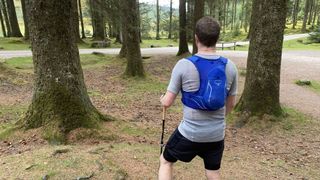
Lightweight running poles are worth every gram when it comes to taking some of the strain off my leg muscles and joints on long-distance, hilly winter runs. I find that they’re also great for stability on frozen terrain and allow me to probe and assess the ground as I go – particularly useful on boulder fields where the gaps may be hidden by soft snow.
River crossings are a very real hazard of the winter environment. Poles enable me to reduce the risk of a crossing. They do this by aiding balance while I hop across, providing another two points of contact and allowing me to probe beneath the surface.
Alex is a freelance adventure writer and mountain leader with an insatiable passion for the mountains. A Cumbrian born and bred, his native English Lake District has a special place in his heart, though he is at least equally happy in North Wales, the Scottish Highlands or the European Alps. Through his hiking, mountaineering, climbing and trail running adventures, Alex aims to inspire others to get outdoors. He's the former President of the London Mountaineering Club, is training to become a winter mountain leader, looking to finally finish bagging all the Wainwright fells of the Lake District and is always keen to head to the 4,000-meter peaks of the Alps. www.alexfoxfield.com

